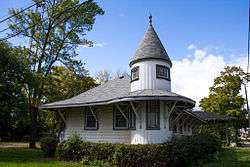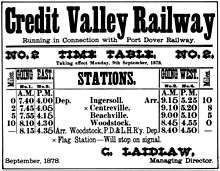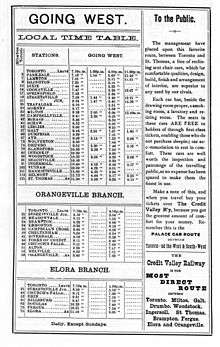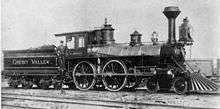Credit Valley Railway
The Credit Valley Railway was a railway located in Ontario, Canada from Toronto to St. Thomas. Chartered in 1871 by Ontario railway magnate George Laidlaw, it operated as an independent company until 1883 when it was leased by the Ontario and Quebec Railway, a Canadian Pacific Railway (CPR) operating company building a network of lines in southern Ontario.
 CVR station in Streetsville. A new station was built in 1914, and the original building was moved to a different location.[1] | |
| Overview | |
|---|---|
| Reporting mark | CVR |
| Locale | Ontario |
| Dates of operation | 1871–1883 |
| Successor | Canadian Pacific Railway |
| Technical | |
| Track gauge | 4 ft 8 1⁄2 in (1,435 mm)[2] |
| Previous gauge | 3 ft 6 in (1,067 mm)[2] |
The section from Toronto to Woodstock remains in use as the CPR mainline through Ontario, forming portions of what is now the Galt and Windsor Subdivisions. The section from Woodstock to St. Thomas is operated by OSR as a short line railway. The branch to Orangeville is currently operated as the Orangeville Brampton Railway. The Elora branch was abandoned and converted to rail trail use.
History
Formation
Following initial discussions held in Milton[3] and Brampton[4] in 1870, the Credit Valley Railway was incorporated by Act of the Legislative Assembly of Ontario in 1871, authorized to build a railway line from Toronto to Orangeville, with branches to Milton, Galt (today part of Cambridge), Berlin (Kitchener) and Waterloo.[5] Later Acts authorized further branches from the Forks of the Credit to Salem,[6] and from Galt to St. Thomas,[7] where it would connect with the Canada Southern Railway. There was also discussion on extending the line to Port Burwell.[8]
In addition to the issue of shares and debt, the CVR's construction was subsidized through other forms of public funding:
| Source | Amount |
|---|---|
| Bonuses contingent on construction of the line | $1,035,000 |
| Exchange of municipal debentures for railway bonds | $75,000 |
| Interest earned on subscriptions | $100,000 |
| Provincial construction subsidy | $420,000 |
| Total public funding | $1,630,000 |
The CVR's president was George Laidlaw,[10] and its chief engineer was James Ross, who later became general manager.[11] Other key players in the company were William Mackenzie,[12] Herbert Samuel Holt[13] and Henry Suckling.[14]
Construction


Originally intended to be an auxiliary narrow gauge line to the Toronto Grey & Bruce Railway,[15] by 1873 its design was changed to standard gauge in order to enable it to become a rival to the Grand Trunk and Great Western lines.[15]
The rail network eventually went from Toronto to Orangeville with branchlines from Cataract to Elora and Streetsville to St. Thomas. Construction occurred in several stages:[16]
- Survey work was done in 1873, with grading beginning early in 1874
- Work was suspended in 1875, and resumed in earnest in the autumn of 1878 following negotiations with the various municipalities for connected bonuses and bond subscriptions[9]
- The line opened from Parkdale railway station to Milton, Ontario in 1877.[17]
- The track reached Brampton, Ontario in December 1878, and the huge trestle, spanning the Credit River near the Credit Forks was completed in September 1879. A station was built at the Forks of the Credit.[18]
- The Milton line was extended to Galt, Ontario in September 1879.
- The line was opened to Orangeville and Elora, Ontario in December 1879.
The Galt line was extended to St. Thomas through a parallel works project:
- a section between Ingersoll and Woodstock was in operation in September 1878, connecting with the Port Dover & Lake Huron Railway
- freight service between Ayr and Ingersoll began in October 1879[19]
- in December 1879, the CVR bridge over the Grand River was opened to rail traffic, and service between Ingersoll and Toronto began in January 1880[19] A test run over the bridge during that month had proved to be successful. By that time, the company had built basic freight and passenger buildings in Galt.[20]
- through service to St. Thomas began in September 1881. It was formally opened in September 1879 by the Governor General of Canada, the Marquis of Lorne.[21] Earlier that year, a carriage carrying its directors on a recently opened length of track was run into by a locomotive, and all suffered serious injuries, of which one was fatal.[22]


- the line passing through Galt was taken over by the Canadian Pacific Railway in 1883; the company built a brick passenger building that still stands.[23]
Extension to Toronto waterfront
The CVR's extension from Parkdale to the waterfront lots in Toronto was met with stiff opposition from the Grand Trunk Railway and the Northern Railway of Canada.[24] In July 1879, the Railway Committee of the Privy Council of Canada ordered that the line be extended to the Esplanade,[25] but the other railways later secured a court order declaring that it did not constitute a right of way.[26][27] The Parliament of Canada subsequently passed an Act on the matter in 1880[28] (which attracted considerable controversy during its debate as it concerned a provincially incorporated railway).[29] All remaining disputes were later resolved through arbitration,[30] leading to connection to the Union Station later that year.[16]
By arrangement with the Michigan Central Railroad, the CVR offered through train service between Toronto and Chicago.[31]
Financial stress
The CVR experienced financial difficulties at various points in its existence, which mainly arose from the effects of the worldwide Long Depression.[32] During its construction, concerns were expressed as to whether it would result in overcapacity in providing rail traffic west of Toronto, which the Toronto Telegram noted:
The enterprise was conceived in folly and nurtured in scheming. Even were it in running order at this moment, it would starve to death for lack of support. It runs midway between the Grand Trunk and Great Western lines, and is as necessary to the welfare of Toronto as would be a sidewalk for passengers down the middle of Yonge Street with the pavement on each side.[33]
Such concerns continued to be expressed after its opening, as existing competition between the GTR and the GWR had already depressed freight rates on that corridor.[9]
As early as 1874, it received approval to settle certain debts through exchange into shares,[34] and in 1876, it was requesting that the provincial construction subsidy of $2000/mile[35] be increased to $3500/mile.[36][37] In 1877, it had to obtain longer terms with respect to the bonds it had issued.[38] Existing provisions allowing municipalities that subsidized the CVR to appoint directors to its board were broadened in 1878,[39] and further provision for exchanging bonds was made in 1880[40] and 1881.[41] George Stephen played a significant role in bailing out the CVR in 1880,[42] together with a group of entrepreneurs organized by E.B. Osler,[43] when the lack of cash prompted a strike over wages being three months in arrears.[44]
Upon its completion in 1881, these difficulties were still present, and discussions arose on the possibility of a lease to the Great Western Railway, while other discussions occurred at the same time concerning the GWR being leased to the CPR.[16] The GWR was eventually leased to the Grand Trunk Railway, and the CPR (through the Ontario and Quebec Railway) acquired the CVR following its acquisition of a 999-year lease to a railway line between Woodstock and London from the London Junction Railway.[43][45] The CVR was amalgamated with the O&Q in 1883.[46] In the following year, The O&Q was taken over by the CPR on January 4.[47]
In 1888, William Van Horne admitted at a meeting that the CPR had been dealing with problems arising from the original construction of the track, declaring, "It takes all our time to try and straighten out the line of the Credit Valley Railway, laid down and built by Mr. Laidlaw, because it is so crooked."[48]
Current status of lines
The line from Toronto to Woodstock now forms part of CP's Galt Subdivision and Windsor Subdivision. The section from Woodstock to St. Thomas is operated by Ontario Southland Railway. The Orangeville branch is now operated by the Orangeville Brampton Railway. The Elora branch was closed in 1987, and has since been converted into a trail by the Credit Valley Conservation Authority and the Grand River Conservation Authority.[49]
Further reading
- Laidlaw, G. (1876). The Credit Valley Railway. Toronto: Copp, Clark & Co.
- Maw, W.H.; Dredge, J., eds. (July 30, 1880). "Credit Valley Railway - I". Engineering. London. XXX: 86–89.
- Maw, W.H.; Dredge, J., eds. (August 20, 1880). "Credit Valley Railway - II". Engineering. London. XXX: 154–156.
- Filby, James (1974). Credit Valley Railway: The third giant. Cheltenham: Boston Mills Press. ISBN 0-91982200-2. reviewed in H.D. Morrison (1975). "Credit Valley Railway: "The third giant"" (PDF). Canadian Rail. Canadian Railroad Historical Association (283): 255–256. ISSN 0008-4875.
- Burnet, Robert G. (Nov–Dec 1995). "CPR and TSR Tracks Through Etobicoke" (PDF). Canadian Rail. Canadian Railroad Historical Association (449): 211–239. ISSN 0008-4875.
References
- "Credit Valley Railway Station, Streetsville". City of Mississauga. 1914.
- Laidlaw 1876, p. 14.
- "Railway Meeting". The Canadian Champion. Milton. December 8, 1870. p. 2.
- "Railroad Meeting". The Canadian Champion. Milton. December 1, 1870. p. 2.
- An Act to Incorporate the Credit Valley Railway Company, S.O. 1870–71, c. 38
- An Act to amend the Act passed in the thirty-fourth year of Her present Majesty's reign, and intituled "An Act to Incorporate the Credit Valley Railway Company," and to extend the powers conferred on the said Company, S.O. 1871–72, c. 47
- An Act to amend the several Acts relating the Credit Valley Railway Company, S.O. 1873, c. 80
- "Credit Valley Extension to Port Burwell". The Globe. Toronto. July 29, 1878. p. 2.
- Engineering 1880b, p. 156.
- McIlwraith, Thomas F. (1982). "Laidlaw, George". In Halpenny, Francess G (ed.). Dictionary of Canadian Biography. XI (1881–1890) (online ed.). University of Toronto Press.
- "James Ross, Noted Financier, is Dead". The Ottawa Citizen. September 20, 1913. p. 1.
- Fleming, R.B. (1991). The Railway King of Canada: Sir William Mackenzie, 1849-1923. Vancouver: UBC Press. p. 13. ISBN 0-7748-0486-6.
- "Sir Herbert Holt, 85, Noted Financier Dies". Ottawa Citizen. September 29, 1941. p. 9.
- "Henry E. Suckling, Treasurer of CPR, Died in 75th Year". The Montreal Gazette. March 23, 1925. p. 5.
- Engineering 1880a, p. 86.
- Kennedy
- Scheinman 2009, p. 13-3.
- "Landscape Inventory Report page 7-31" (PDF). 1 March 2016. Retrieved 26 February 2019.
With the rail link in place, Credit Valley sandstone was shipped throughout southern Ontario but primarily to Toronto and Hamilton. Queen’s Park and the old Toronto City Hall are two significant examples of the many important buildings completed in this material. Four varieties of ‘dimension’ sandstone were available from the Forks’ quarries: a grey with occasional brown spots; a uniform grey stone of particularly high quality; a brownstone which varied from chocolate to deep brown depending on the quarry with occasional deposits of a pinkish brown stone (particularly prized) and a piebald mix of white and brown stone.
- W. H. Breithaupt (1917). "Waterloo County Railway History (President's Address - Fifth Annual Report of the Waterloo Historical Society)". Waterloo Historical Society.
- https://www.therecord.com/living-story/8035119-flash-from-the-past-private-moment-goes-public-in-galt-rail-yard/
- "Vice-Regal Visit to our County Town". The Acton Free Press. Acton. September 25, 1879. p. 2.
- "Terrible Railroad Accident!". The Montreal Gazette. May 12, 1879. p. 3.
- https://www.therecord.com/living-story/8035119-flash-from-the-past-private-moment-goes-public-in-galt-rail-yard/
- George Laidlaw (January 28, 1880). "The Credit Valley Railway (letter)". The Montreal Gazette. p. 2.
- Application of the Credit Valley Railway for Right of Way and Crossings at the City of Toronto. Toronto: Hunter Rose & Co. 1880. pp. 7–8.
- "The Grand Trunk Railway Company v. The Credit Valley Railway Company". The Canada Law Journal. XV: 271. September 1879.
- "Toronto". The Daily Advertiser. London. January 8, 1880. p. 1.
- An Act respecting the Credit Valley Railway Company, S.C. 1880, c. 54
- "Credit Valley Railway Company Bill (Bill 53), Second Reading". Parliamentary Debates (Hansard). Canada: House of Commons. March 10, 1880. pp. 584–590.
- Trevelyan Ridout (1883). Statutes Special and General, Relating to the Northern Railway Company of Canada. Toronto: Hunter Rose & Co. pp. 453–458.
- "Timetable: Credit Valley Railway". October 10, 1883.
- Burnet 1995, p. 213.
- "The Position of the Country". The Acton Free Press. Acton. June 8, 1876. p. 2.
- An Act amending Acts relating to the Credit Valley Railway Company, S.O. 1874, 1st Sess., c. 42
- authorized by An Act respecting aid to certain Railways, and for other Purposes, S.O. 1875–76, c. 22, s. 1(4)
- Laidlaw 1876, p. 3.
- $3460.80/mile (in half-yearly instalments over twenty years) was granted under An Act respecting aid to certain Railways and the creation of a Railway Land Subsidy Fund, S.O. 1877, c. 14, s. 1(5)
- An Act respecting the Credit Valley Railway Company, S.O. 1877, c. 77
- An Act respecting the Credit Valley Railway Company, S.O. 1878, c. 44
- An Act to amend the Acts relating to the Credit Valley Railway Company, S.O. 1880, c. 52
- An Act to amend the Acts relating to the Credit Valley Railway Company, S.O. 1881, c. 61
- Berton, Pierre (1971). The Last Spike. Toronto: McClelland & Stewart. p. 127. ISBN 0-7710-1327-2.
- Burnet 1995, p. 215.
- "Strike on the Credit Valley". The Globe. Toronto. July 8, 1880. p. 3.
- "Credit Valley Railway Co". The Toronto Daily Mail. October 13, 1883. p. 9.
- An Act respecting the Credit Valley Railway Company, S.O. 1882–83, c. 50 , and An Act to amend an Act to incorporate the Ontario and Quebec Railway Company, S.C. 1883, c. 58
- "Inventory Report page 13-3" (PDF). Caledon. 1 March 2011. Retrieved 26 February 2019.
- "New C.P.R. Branch". The Canadian Champion. Milton. August 2, 1888. p. 2.
- "Elora Cataract Trailway". GRCA. Archived from the original on 2006-09-08. Retrieved 2014-09-15.
External links
- Kennedy, R.L. "Credit Valley Railway". Trainweb.
- Scheinman, André (March 2009). "13: Former CVR Railway". Cultural Heritage Landscapes Inventory (PDF). Town of Caledon.
See also
